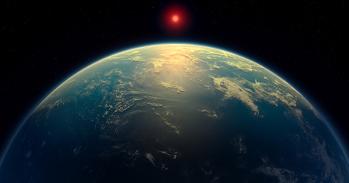Research indicates the existence of Earth-like planets in dead solar system through latest chemical analysis techniques
Research indicates the existence of Earth-like planets in dead solar system through latest chemical analysis techniques
Is there another recipe for life? The chemistry can tell us
Jay Farihi
By chemically sampling the atmospheres of two dead stars in the Hyades cluster 150 light years away, researchers at Cambridge and NASA/ESA’s Hubble Space Telescope have discovered the building blocks for Earth-sized planets formed around the stars while they lived.
The study offers insight into what will happen in our solar system when our Sun burns out 5 billion years from now. It is published today in Monthly Notices of the Royal Astronomical Society.
The dead stars - called white dwarfs - are the burned-out cores of Sun-like stars. The finding suggests that terrestrial planets formed around these white dwarfs when they were young stars.
Researchers found the white dwarfs’ atmospheres “polluted” with silicon - rocky material that makes up Earth and other terrestrial planets in our solar system.
This silicon pollution likely occurred when the dwarf’s gravity shredded asteroids that got sucked in to its pull, after asteroid belts were initially disrupted by the gravity of surviving Jupiter-sized planets - with debris settling into a ring around the dead stars similar to the rings of Saturn.
“When these stars were born, they built planets, and there’s a good chance they are retaining some of them,” said lead investigator Dr Jay Farihi of Cambridge’s Institute of Astronomy.
“The rocks we are seeing are evidence for the Lego building blocks of planets. Both of these stars show asteroids being thrown around, which tells us that rocky planet assembly is common.”
Although the cluster is relatively young at 625 million years old, the dead stars provide clues as to what might happen when our Sun eventually burns out:
After exhausting its hydrogen fuel, the Sun will likely puff up to a red giant and destroy several terrestrial planets including Earth, losing mass as it ejects outer layers.
The balance of gravitational power between the Sun and Jupiter would change, wreaking havoc on the asteroids in the belt located between Mars and Jupiter. Some of these asteroids could veer too close to the Sun’s gravity, breaking them into debris that could be pulled into a ring around our dead Sun - similar to the inferred rings around the Hyades white dwarfs.
To conduct the new analysis, researchers used Hubble’s powerful Cosmic Origins Spectrograph to divide the stars’ ultraviolet light into its constituent colours, providing information on the chemical elements in the atmosphere.
The silicon-carbon ratio in the stars’ atmospheres rules out everything except for rock, according to researchers, who say they have chemical evidence that this material is “at least as rocky as the most primitive bodies” in our own solar system.
“The one thing the white dwarf pollution technique gives us that we just won’t get with any other planet-detection technique is the chemistry of a planet,” Farihi said.
“Based on the silicon-to-carbon ratio in our study, for example, we can actually say that this material looks like the stuff in our back yard. If you put this stuff into the hand of any human being they would be able to tell you this is a rock, they wouldn’t need to be a scientist. It’s something familiar to all of us.”
The debris most likely polluted the white dwarfs’ atmosphere when asteroids wandered too close to the stellar relics. “Basically, you need planets to throw the rocks around. It’s pretty hard to imagine another mechanism than gravity that causes material to rain down onto the star.”
Farihi suggested that asteroids less than 100 miles across were probably gravitationally torn apart by the white dwarfs. The pulverized material was pulled into a ring that could superficially resemble Saturn’s rings. The dusty material swirling in the rings eventually settled onto the stars.
The researchers estimated the asteroid’s size by measuring the amount of dust consumed by the stars, about 10 million grams per second - equal to a small river. They then compared that measurement with those from previous observations.
The team plan to analyse more white dwarfs using the same technique to identify not only the rocks’ composition but also their parent bodies. “We have been using our solar system as a kind of a map, but I don’t know what the universe does,” Farihi said. “The universe might be doing something different. We really want to build up a picture of the different families rocks.
“The beauty of this technique is that whatever the universe is doing, we’ll be able to measure it. Is there another recipe for life? The chemistry can tell us. Hopefully, with Hubble and the upcoming ground-based 30-meter telescopes, we’ll be able to tell a story.
“We can build a picture of hundreds of these things and tell how often it looks like Earth and how often it looks weird and strange. Who knows, maybe we’ll find stuff we haven’t thought of yet.”
For more information, please contact fred.lewsey@admin.cam.ac.uk
This work is licensed under a Creative Commons Licence. If you use this content on your site please link back to this page.





